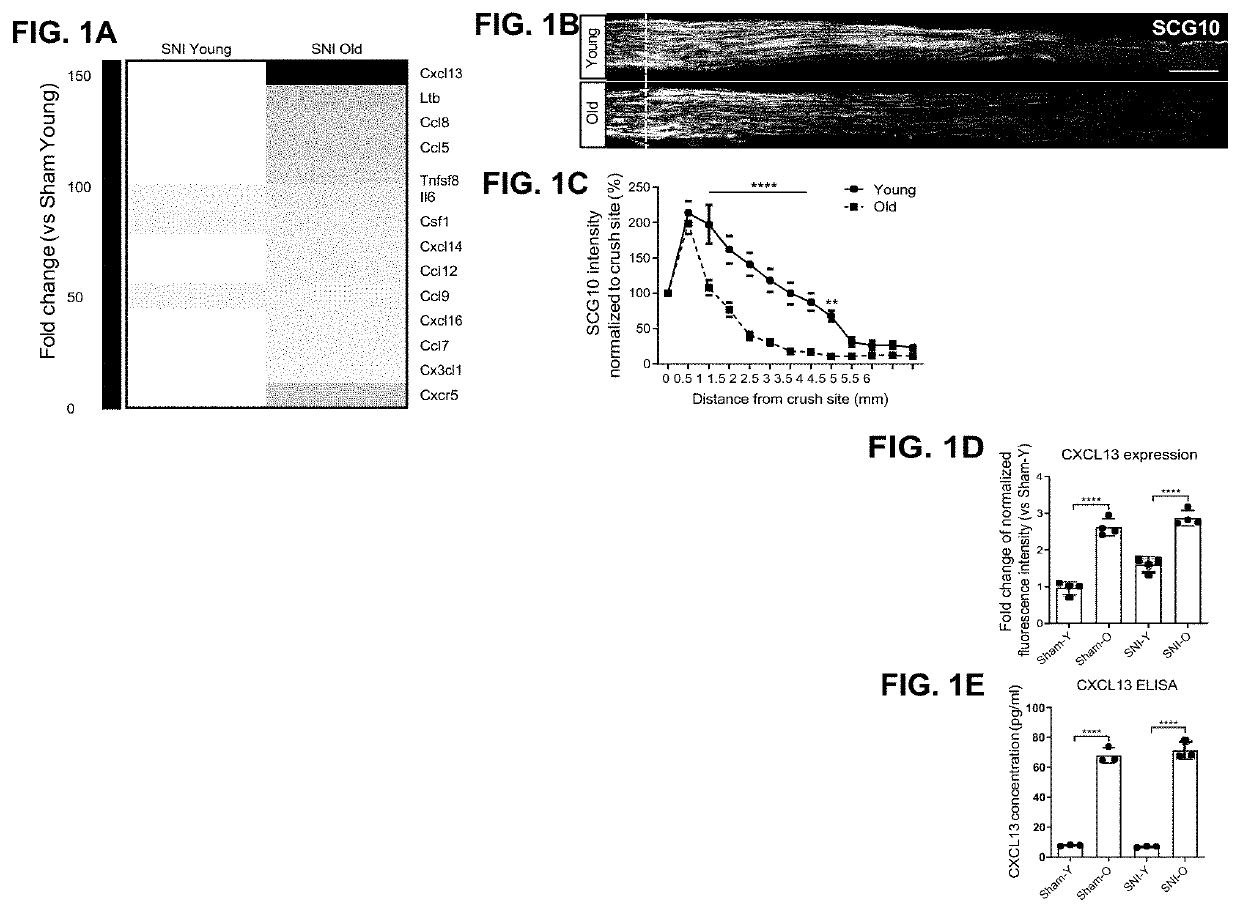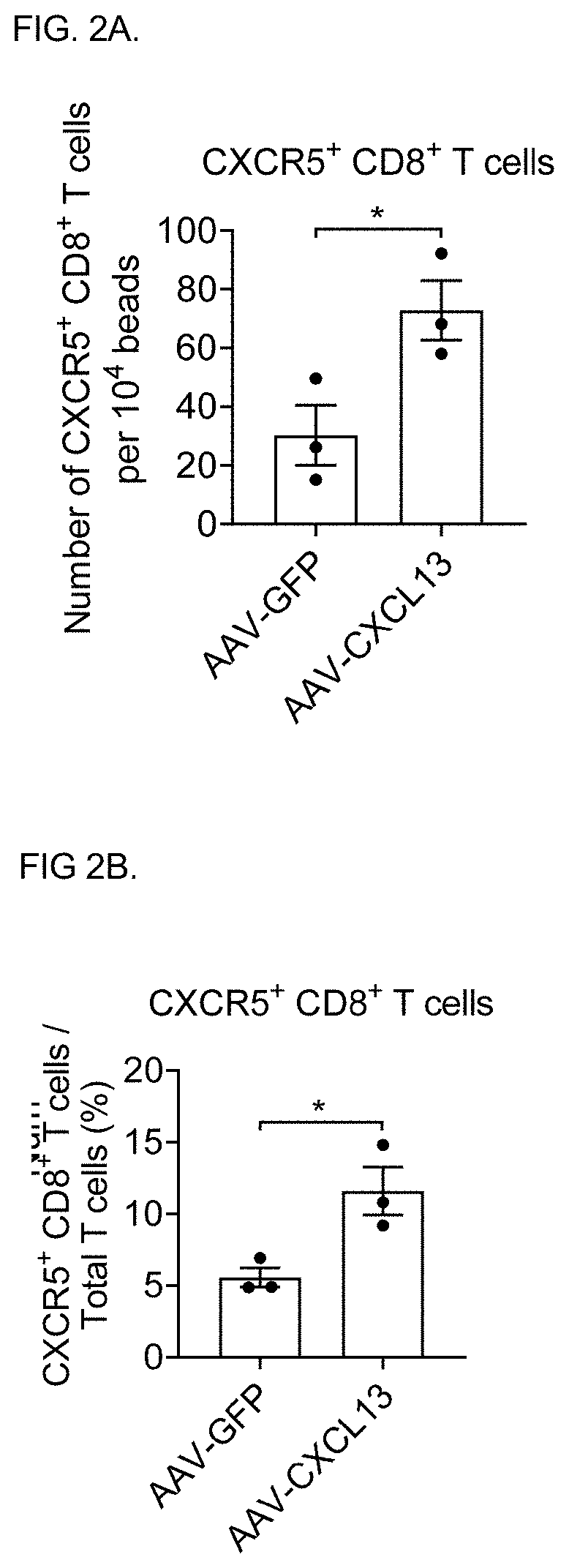Use of cxcl13 binding molecules to promote peripheral nerve regeneration
a technology of cxcl13 and binding molecules, which is applied in the direction of peptides, muscular disorders, drug compositions, etc., can solve the problems of increasing long-term disability, affecting peripheral nerve regeneration, and aging-related decline of axonal regenerative ability and repair processes, so as to promote peripheral nerve regeneration and improve peripheral nerve regeneration
- Summary
- Abstract
- Description
- Claims
- Application Information
AI Technical Summary
Benefits of technology
Problems solved by technology
Method used
Image
Examples
example 1
tal Materials and Methods
[0133]The following materials, methods and protocols were applied in the Examples that follow.
[0134]Mice
[0135]8 to 10 week old wildtype C57 / BL6J mice from were obtained from Charles River, and the aged mice (20 to 22-month-old) were supplied from either Charles River or the Jucker's laboratory, HIH, Tuebingen. OT I mice with a B57 / BL6 genetic background were provided by the Botto's laboratory, Imperial College. All animal procedures were performed in accordance with the UK Animals Scientific Procedures Act (1986) and approved by the ethical committee of Imperial College London.
[0136]DRG Cell Culture
[0137]Sterile 15 mm glass coverslips in 24-well plates were coated with 0.003% Poly-L-ornithine (Sigma) diluted in H2O for 1 hour at 37° C. After 3 times washing with water, the coverslips were coated with 1 μg / ml laminin (Millipore) prepared in PBS (Invitrogen) for 3 hours at room temperature. After 2 wash steps with PBS, the wells were filled with DMEM and place...
example 2
f Aging on Gene Expression Following Nerve Injury: Neuronal CXCL13 is Elevated in Aged DRG
[0169]The effects of aging on gene expression in dorsal root ganglia (DRG) were assessed by RNA sequencing (RNA seq) from sciatic DRG obtained from 8-10 weeks old (young) mice and 20-22 weeks old (aged) mice proceeding (sham) and following nerve injury. The sciatic nerve of X number of young and aged mice was crushed by applying pressure to the nerve with forceps. Each mouse was injured or sham treated at approximately the same point in the sciatic nerve as described above. After 24 hours, the DRG near the site of sciatic nerve injury (SNI) or sham injury were removed, RNA extracted therefrom, and sequenced. Changes in gene expression from DRG were assessed in aged sham, young and aged after SNI in comparison to the baseline expression in young sham animals. Significantly differentially expressed (DE) genes (FDR<0.05) were analyzed by Gene Ontology (GO) and KEGG for functional classification. T...
example 3
lls Expressing the CXCL13 Receptor CXCR5 are Elevated in Aged DRG
[0171]To determine whether in vivo neuronal expression of CXCL13 attracts CXCR5+ T cells, CXCL13 was overexpressed in DRG neurons by infecting sciatic nerves of young mice with AAV-GFP or AAV-CXCL13-GFP. Six weeks after infection, interferon-y (IFN-7) and mannitol were delivered systemically to induce MHC-I presentation and favor blood barrier permeability respectively; immediately thereafter a sciatic nerve crush was performed and CXCR5+ T cells were measured by FACS in sciatic DRG at day 3 post-injury (data not shown). Interestingly, it was found that CXCR5+CD8+ T cells were significantly increased in CXCL13 overexpressing DRG compared to GFP control (FIGS. 2A and B).
[0172]Since CXCL13 is a chemoattractant for CXCR5 positive B and T cells, the localization and immunophenotype of CD8+ T cells within the DRG were assessed. Immunostaining showed that the number of CXCR5+CD8+ T cells was significantly higher in aged scia...
PUM
| Property | Measurement | Unit |
|---|---|---|
| temperature | aaaaa | aaaaa |
| temperature | aaaaa | aaaaa |
| flow rate | aaaaa | aaaaa |
Abstract
Description
Claims
Application Information
 Login to View More
Login to View More - R&D
- Intellectual Property
- Life Sciences
- Materials
- Tech Scout
- Unparalleled Data Quality
- Higher Quality Content
- 60% Fewer Hallucinations
Browse by: Latest US Patents, China's latest patents, Technical Efficacy Thesaurus, Application Domain, Technology Topic, Popular Technical Reports.
© 2025 PatSnap. All rights reserved.Legal|Privacy policy|Modern Slavery Act Transparency Statement|Sitemap|About US| Contact US: help@patsnap.com



